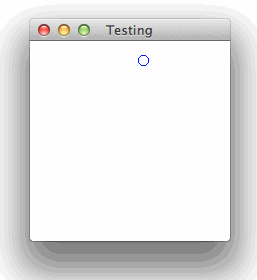Start by talking a look at Performing Custom Painting and Painting in AWT and Swing for details about how painting is performed in Swing.
Take a look at Concurrency in Swing for details about dealing with Swing a threads.
Basically, only a component on a displayed container will be painted. This means that only your Plansza will be painted, but only when it's added to a (directly or otherwise) something like JFrame and the JFrame is made visible.
This means that Wilk can never be painted and therefore it's paintComponent method becomes somewhat pointless (in this context)
What you could use is some way to communicate what you want to paint from your Wilk (controller) to Plansza (view). This is typically achieved via the use of some kind of model, which allows your controller to change it's state and your view to render that state.
For example...

This is a basic demonstration of a Model-Control-View implementation.
The model drives the view and the controller drives the model. In this way, so long as the contract of the model is meet, the various elements are independent of each other
import java.awt.Color;
import java.awt.Dimension;
import java.awt.EventQueue;
import java.awt.Graphics;
import java.awt.Graphics2D;
import java.awt.Rectangle;
import java.util.ArrayList;
import java.util.Iterator;
import java.util.List;
import javax.swing.JComponent;
import javax.swing.JFrame;
import javax.swing.UIManager;
import javax.swing.UnsupportedLookAndFeelException;
import javax.swing.event.ChangeEvent;
import javax.swing.event.ChangeListener;
public class PaintModel {
public static void main(String[] args) {
new PaintModel();
}
public PaintModel() {
EventQueue.invokeLater(new Runnable() {
@Override
public void run() {
try {
UIManager.setLookAndFeel(UIManager.getSystemLookAndFeelClassName());
} catch (ClassNotFoundException | InstantiationException | IllegalAccessException | UnsupportedLookAndFeelException ex) {
ex.printStackTrace();
}
MutableModel model = new DefaultModel();
Controller controller = new Controller(model);
JFrame frame = new JFrame("Testing");
frame.setDefaultCloseOperation(JFrame.EXIT_ON_CLOSE);
frame.add(new View(model));
frame.pack();
frame.setLocationRelativeTo(null);
frame.setVisible(true);
controller.start();
}
});
}
public interface Model {
public Rectangle getBounds();
public Dimension getSize();
public void addChangeListener(ChangeListener listener);
public void removeChangeListener(ChangeListener listener);
}
public interface MutableModel extends Model {
public void update();
}
public class DefaultModel implements MutableModel {
private final Dimension size = new Dimension(200, 200);
private final Rectangle bounds = new Rectangle(95, 95, 10, 10);
private int xDelta = ((int) (Math.random() * 5)) + 1;
private int yDelta = ((int) (Math.random() * 5)) + 1;
private List<ChangeListener> changeListeners;
public DefaultModel() {
changeListeners = new ArrayList<>(25);
}
@Override
public void addChangeListener(ChangeListener listener) {
changeListeners.add(listener);
}
@Override
public void removeChangeListener(ChangeListener listener) {
changeListeners.remove(listener);
}
protected void fireStateChanged() {
if (changeListeners.size() > 0) {
ChangeEvent evt = new ChangeEvent(this);
Iterator<ChangeListener> it = changeListeners.iterator();
while (it.hasNext()) {
ChangeListener listener = it.next();
listener.stateChanged(evt);
}
}
}
@Override
public Dimension getSize() {
return size;
}
@Override
public Rectangle getBounds() {
return bounds;
}
@Override
public void update() {
bounds.x += xDelta;
bounds.y += yDelta;
if (bounds.x < 0) {
bounds.x = 0;
xDelta *= -1;
} else if (bounds.x + bounds.width > size.width) {
bounds.x = size.width - bounds.width;
xDelta *= -1;
}
if (bounds.y < 0) {
bounds.y = 0;
yDelta *= -1;
} else if (bounds.y + bounds.height > size.height) {
bounds.y = size.height - bounds.height;
yDelta *= -1;
}
fireStateChanged();
}
}
public class Controller extends Thread {
private MutableModel model;
public Controller(MutableModel model) {
this.model = model;
setDaemon(true);
}
@Override
public void run() {
while (true) {
try {
Thread.sleep(40);
} catch (InterruptedException ex) {
}
model.update();
}
}
}
public class View extends JComponent implements ChangeListener {
private Model model;
public View(Model model) {
this.model = model;
this.model.addChangeListener(this);
setBackground(Color.WHITE);
}
@Override
public Dimension getPreferredSize() {
return new Dimension(model.getSize());
}
@Override
protected void paintComponent(Graphics g) {
super.paintComponent(g);
Graphics2D g2d = (Graphics2D) g.create();
g2d.setColor(getBackground());
g2d.fillRect(0, 0, getWidth(), getHeight());
Rectangle bounds = model.getBounds();
g2d.setColor(Color.BLUE);
g2d.drawOval(bounds.x, bounds.y, bounds.width, bounds.height);
g2d.dispose();
}
@Override
public void stateChanged(ChangeEvent e) {
repaint();
}
}
}